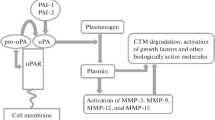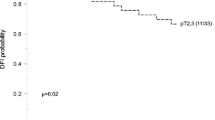Abstract
The expression of urokinase-type plasminogen activator (u-PA), u-PA receptor (u-PAR) and plasminogen activator inhibitor (PAI) 1 and 2 was examined in 105 cases of primary lung cancer tissue using immunohistochemical staining and reverse transcriptase polymerase chain reaction (RT-PCR) techniques. The expression of u-PA, u-PAR and PAI-1 was detected in approximately 80% of primary lung cancers, whereas detectable PAI-2 expression was observed only in half of the overall cases. We assessed the relationships between the expression pattern and clinicopathological findings and found that a diminished expression level of PAI-2 was significantly correlated with lymph node metastasis and a poor prognosis. These results indicate that PAI-2 may play a critical role in the regulation of extracellular matrix degradation during tumour cell invasion and metastasis, and the expression of PAI-2 may be useful as a marker for evaluating the prognosis of lung cancer.
Similar content being viewed by others
Author information
Authors and Affiliations
Rights and permissions
About this article
Cite this article
Yoshino, H., Endo, Y., Watanabe, Y. et al. Significance of plasminogen activator inhibitor 2 as a prognostic marker in primary lung cancer: association of decreased plasminogen activator inhibitor 2 with lymph node metastasis. Br J Cancer 78, 833–839 (1998). https://doi.org/10.1038/bjc.1998.588
Issue Date:
DOI: https://doi.org/10.1038/bjc.1998.588
- Springer Nature Limited
This article is cited by
-
SerpinB2 is involved in cellular response upon UV irradiation
Scientific Reports (2019)
-
Down-regulation of SerpinB2 is associated with gefitinib resistance in non-small cell lung cancer and enhances invadopodia-like structure protrusions
Scientific Reports (2016)
-
Decreased expression of SERPINB1 correlates with tumor invasion and poor prognosis in hepatocellular carcinoma
Journal of Molecular Histology (2014)
-
Urokinase Receptor Orchestrates the Plasminogen System in Airway Epithelial Cell Function
Lung (2013)




